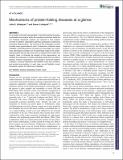Mechanisms of protein-folding diseases at a glance
Author(s)
Valastyan, Julie Suzanne; Lindquist, Susan
DownloadLindquist_Mechanisms of protein.pdf (728.2Kb)
PUBLISHER_CC
Publisher with Creative Commons License
Creative Commons Attribution
Terms of use
Metadata
Show full item recordAbstract
For a protein to function appropriately, it must first achieve its proper conformation and location within the crowded environment inside the cell. Multiple chaperone systems are required to fold proteins correctly. In addition, degradation pathways participate by destroying improperly folded proteins. The intricacy of this multisystem process provides many opportunities for error. Furthermore, mutations cause misfolded, nonfunctional forms of proteins to accumulate. As a result, many pathological conditions are fundamentally rooted in the protein-folding problem that all cells must solve to maintain their function and integrity. Here, to illustrate the breadth of this phenomenon, we describe five examples of protein-misfolding events that can lead to disease: improper degradation, mislocalization, dominant-negative mutations, structural alterations that establish novel toxic functions, and amyloid accumulation. In each case, we will highlight current therapeutic options for battling such diseases.
Date issued
2014-01Department
Massachusetts Institute of Technology. Department of Biology; Whitehead Institute for Biomedical ResearchJournal
Disease Models & Mechanisms
Publisher
Company of Biologists
Citation
Valastyan, J. S., and S. Lindquist. “Mechanisms of protein-folding diseases at a glance.” Disease Models & Mechanisms 7, no. 1 (January 6, 2014): 9-14.
Version: Final published version
ISSN
1754-8403
1754-8411